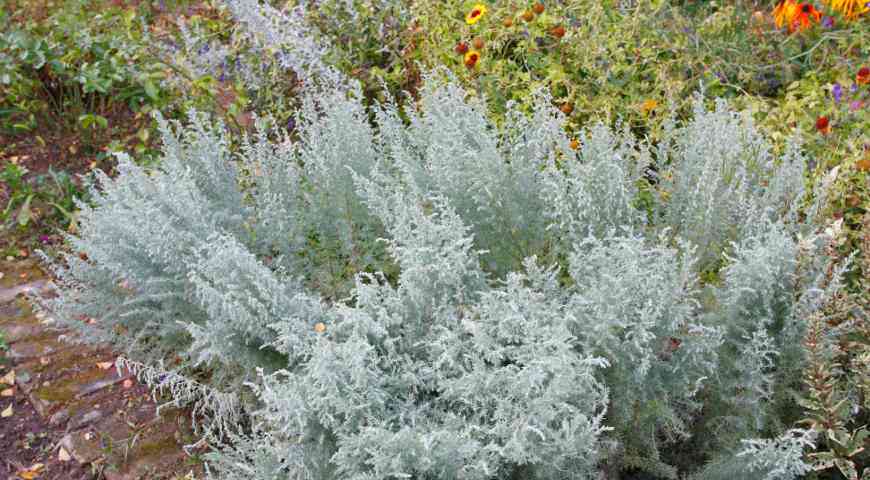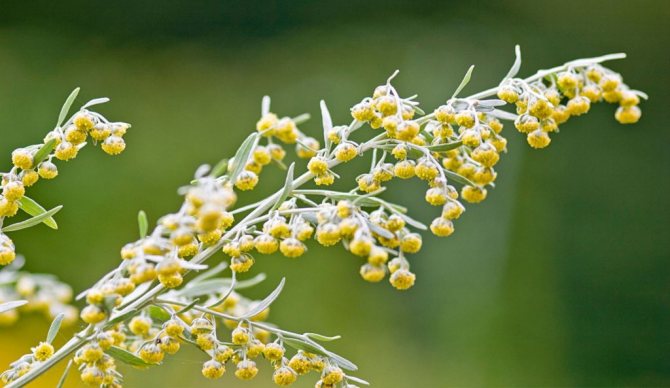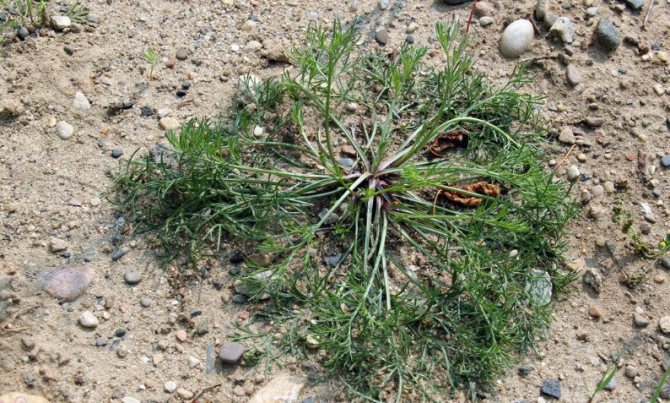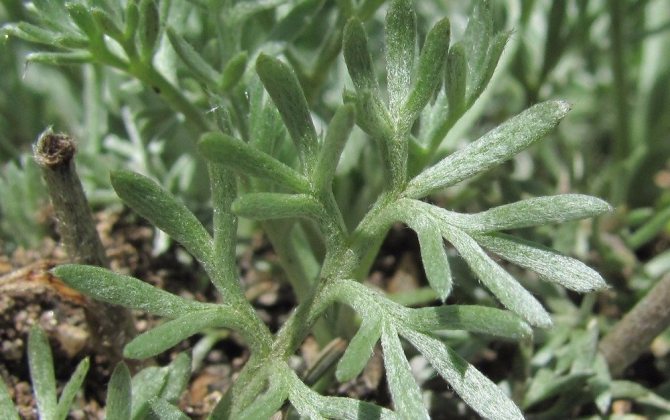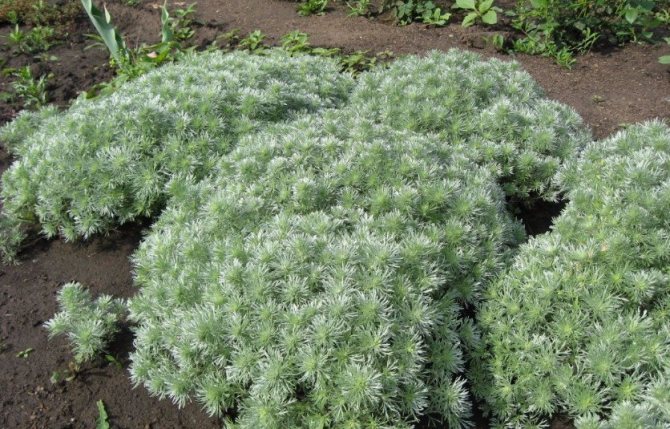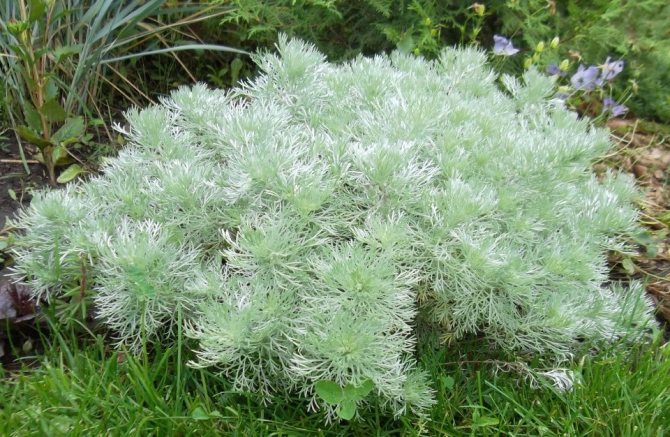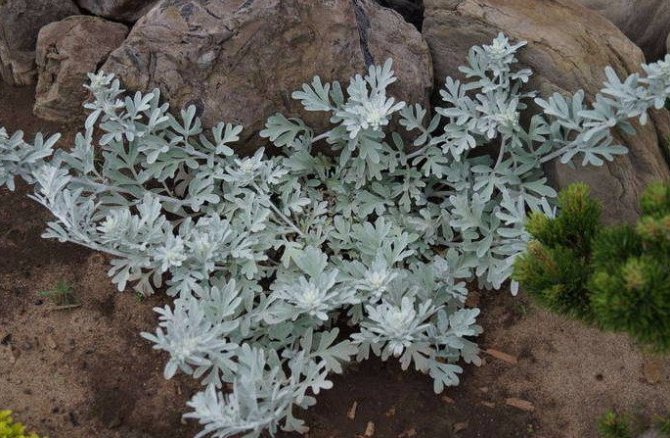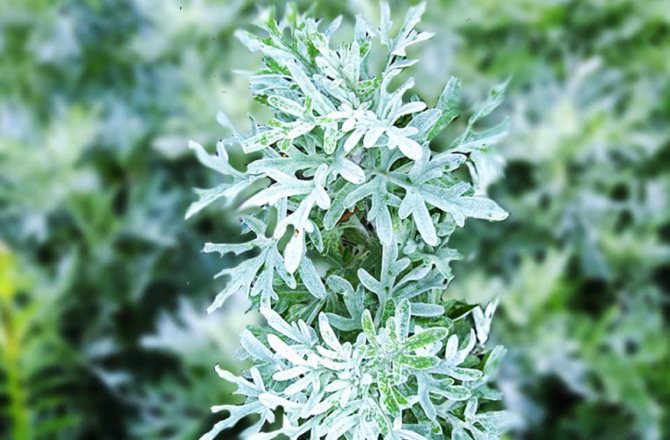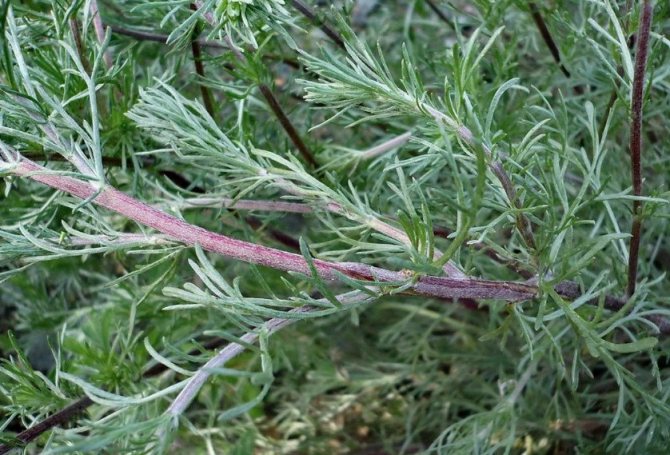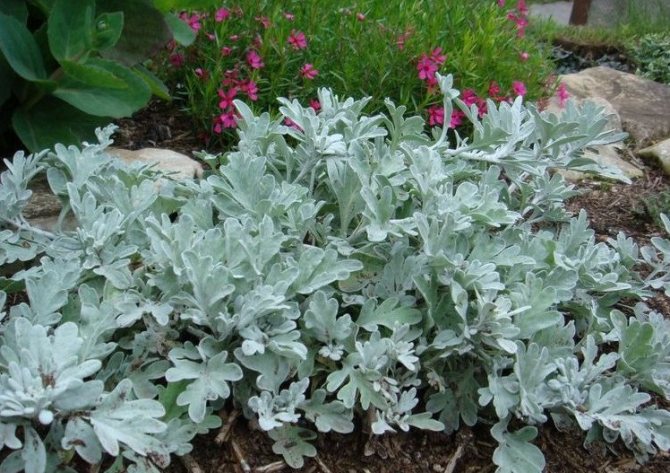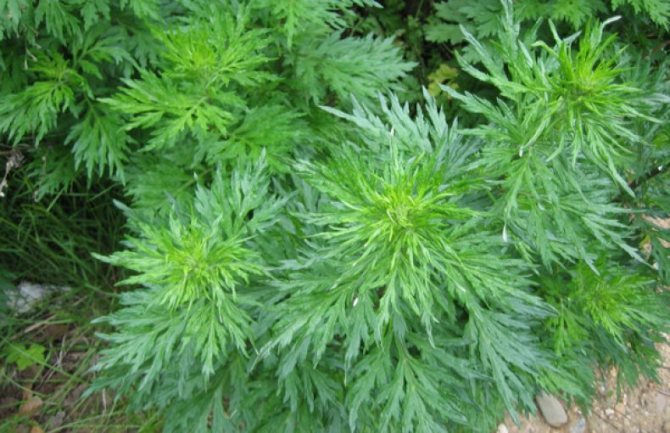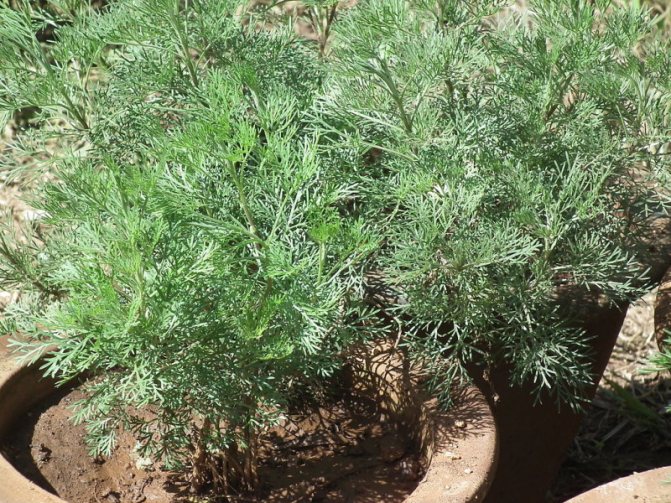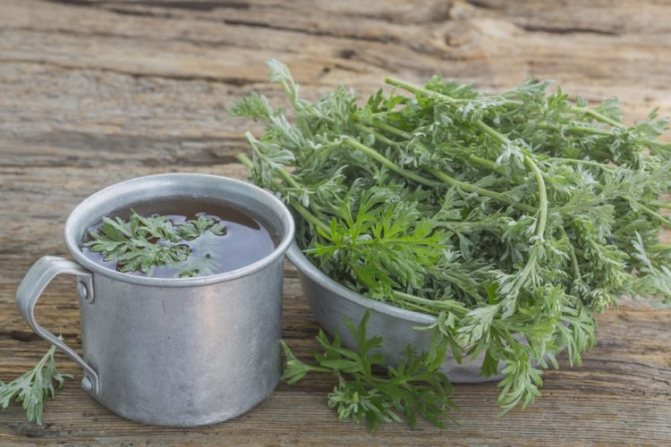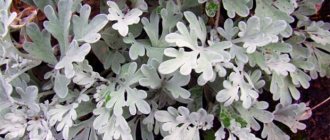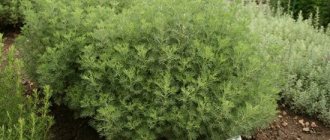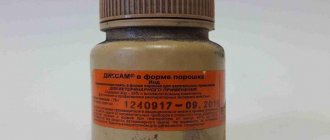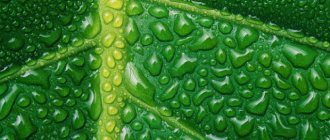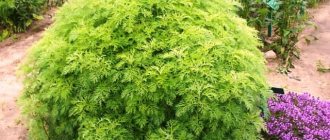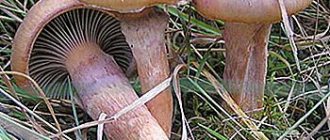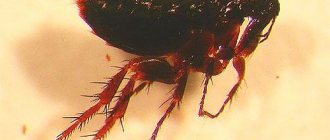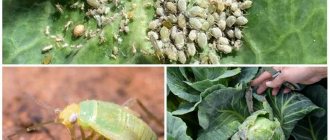This plant got its scientific name in honor of the Greek goddess Artemis. The genus Wormwood includes about 300 species of grasses and shrubs that grow in the temperate regions of the Northern Hemisphere.

Sagebrush. Photo for publication used under standard license <499 Other names:
- wormwood - chernobyl
Parts used:
- all parts of the plant
Since wormwood repels insects, they can be planted around the perimeter of the garden as companion plants.
Reproduction
Seeds or semi-lignified cuttings (in summer). Rhizome species are propagated by division in spring or autumn. Wormwood is sown in spring.
Care
In the spring, light pruning is shown to stimulate growth (wormwood is pruned more strongly). All types of wormwood are drought-resistant, and most are frost-resistant.
Pests and diseases
Occasionally wormwood is affected.
Procurement and storage
Leaves (used fresh or dried) are harvested as needed.
Wormwood properties
Bitter wormwood is a very valuable medicinal plant, the history of it goes back far into the past. Among the ancient Slavs, wormwood was considered a cult plant with the ability to cleanse the spiritual and physical world.
Subscribe to our INSTAGRAM account!
Many people are still confident that the aroma (smell) of wormwood scares away evil spirits, protects from the evil eye and damage.
In Latin, wormwood sounds like "Artemisia" - in honor of the famous goddess Artemis, who discovered many of the healing properties of plants.
The most popular among the people for its healing, cleansing and cosmetic properties received wormwood... It differs from other types of medicinal properties, as well as outwardly - grayish-silver color. The upper surfaces of the leaves of wormwood are whitish in color, and the stem also looks silky-grayish. And the flower baskets of this plant are yellow or yellow-green.
Bitter wormwood is a perennial wild plant with a characteristic specific aroma and a very bitter taste. The smell of wormwood is quite strong and resembles a bitter-tart taste. It grows almost everywhere, has a straight, up to 1.5 m in height, spreading stem.
Bitter wormwood is a home remedy that has long been tested by our ancestors. The ground part of the plant is used for application and treatment. without the lower lignified parts of the stems, as well as flowers and roots.
Wormwood leaves are harvested before flowering, plucking them without petioles. The stems of the plant with the tops are cut at the beginning of flowering. Dry in the shade in a well-ventilated area. The shelf life of harvested herbs is 2 years.
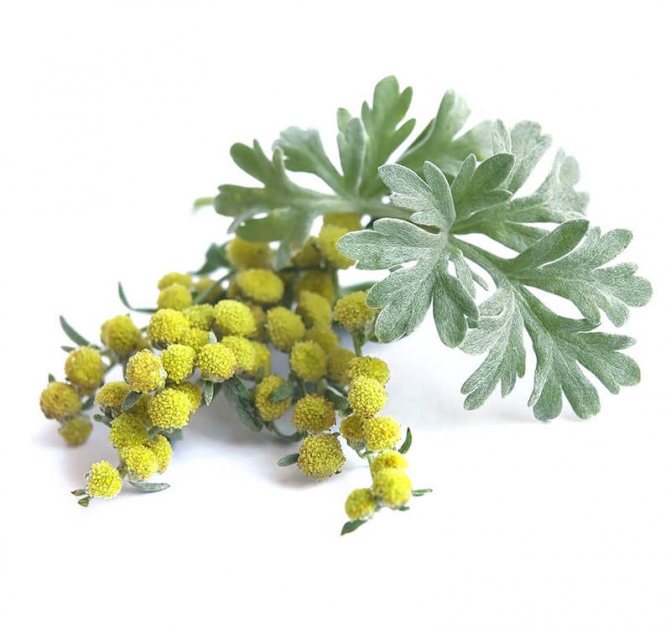

The bitter taste of wormwood stimulates the vital activity of the body, gives an excellent tone, has healing and cleansing properties. The value of wormwood and its use has increased even more with a number of discoveries in the field of microorganisms that inhabit our body. Not all of them appear to be useful to us. Such as toxoplasma, chlamydia, Trichomonas, gonococcus, yeast, viruses, mycoplasma, ureaplasma, gardnerella, etc. slowly but surely destroy the human body, leading to chronic and serious diseases.
As scientific studies have shown, about 90% of the entire population of the planet is affected by parasites, in one degree or another.
The presence of such a pyogenic infection causes metabolic disorders in the body, leads to inflammation of the small intestine, various diseases of the liver and biliary tract, skin diseases (diathesis, allergies, urticaria, eczema, psoriasis, etc.), heart attack, various colds with mucus secretion and pus.
Wormwood is one of the most effective, affordable and natural remedies in the fight against these microorganisms.
Stunted species
Wormwood Schmidt


A perennial herb with a bitter-spicy aroma, up to 20 cm high. The leaves are silvery in color with a deep dissection. It is used in landscape design to decorate curbs and rocky hills, it looks no less interesting in flower beds. An excellent contrasting background for bright short roses.
Important! The advantage of planting the Schmidt wormwood bush is its rapid growth. But it must be remembered that with increased soil moisture and frequent watering, the stems and leaves become more saturated green, while the fluffiness is lost, all this is fraught with the loss of decorative attractiveness.
Cold wormwood
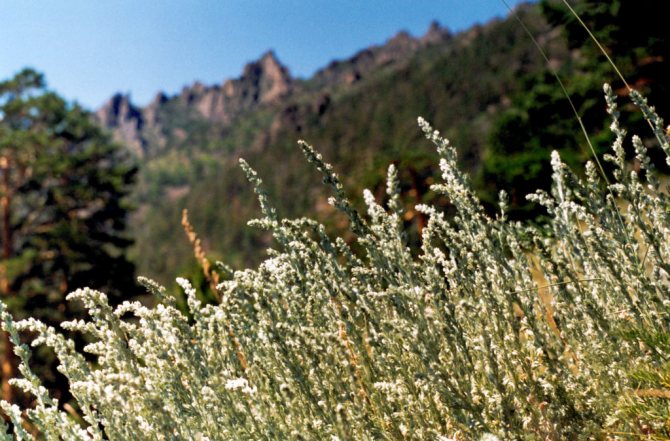

It reaches a height of 40 cm, leaves are pale in color. Flowers can be purplish pink or yellow. Leaves, fruits, roots, grass and inflorescences are used for treatment. Infusions and decoctions have expectorant, diaphoretic and antipyretic properties. Used for diphtheria, bronchitis, cough, malaria, pneumonia and pulmonary tuberculosis. Topically, the infusion is used for compresses for neuralgia, gout and rheumatism. They are also advised to wash eczema, burns, non-healing wounds, ulcers, allergies.
Steller's wormwood


The main feature of this species is its delicate leaves, which are silvery and pleasant to the touch. It is used as a garden decoration. You can decorate the slopes of terraces, retaining walls, rocky slides, it goes well and serves as a backdrop for bright plants. This wormwood shrub goes well with sage, some varieties of cloves and low bells.
Brilliant wormwood
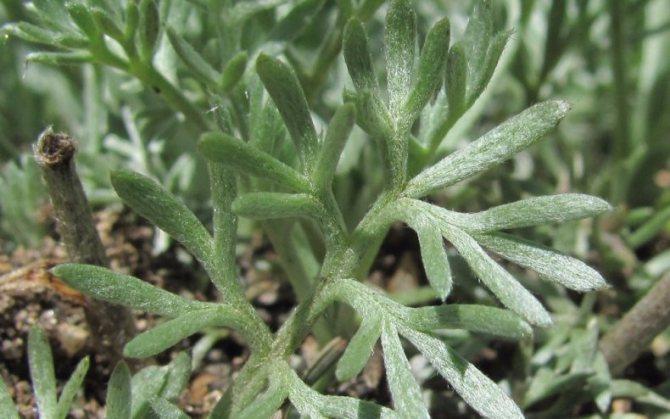

It is characterized by a silvery coating that can be seen on the leaves, as well as a pronounced odor. The leaf plates are flat, thin and very low. This species has also found application in landscape design. This species is planted next to flower walls, in the steppe areas of the garden and on rocky walls. The value of the plant lies in the preservation of its decorative qualities even in winter.
Field wormwood


Perennial plant, glabrous or with adpressed grayish pubescence, up to 80 cm in height. Used for medical purposes. Treat urogynecological diseases, stomach diseases, epilepsy. On the basis of fresh leaves and pork fat, an ointment is made for healing wounds. Wool and cotton were dyed green with a decoction of aerial parts. Household purpose - as feed for sheep, horses, cattle, as well as for rabbits.
Cleaning with wormwood
Regular cleansing of the body with a decoction of wormwood, douching with it (1 tsp at boiling water, leave for 10 minutes - in the morning and in the evening) is a very necessary and effective procedure that women need to do periodically.
Wormwood is also very valuable in cleansing the body of various types of worms (parasites), both alone and in combination (assembled) with other herbs.
Parasites not only consume all the most valuable and useful of what we eat, but also shit into our body, poisoning it with their waste products. They are dangerous in that they can quietly and imperceptibly kill a person, gradually taking away his strength, and when he weakens, they multiply with even greater intensity.
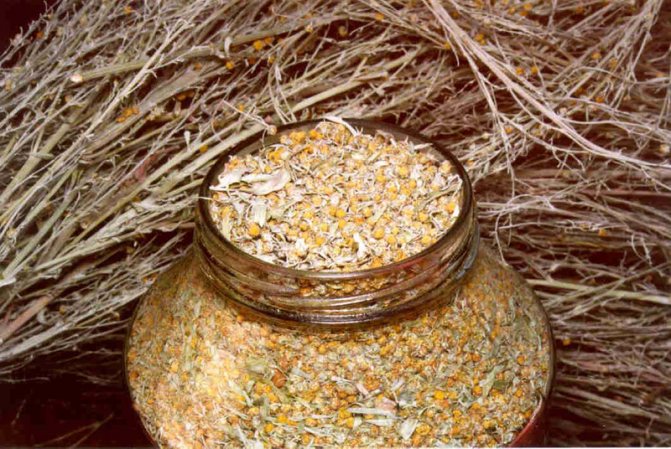

Chemical composition
Field wormwood herb contains a huge list of various vitamins, trace elements and organic substances that have a complex therapeutic effect on the human body.Here is a short list of useful substances that can be found in it:
- Vitamin A. Shows the strongest antioxidant properties, is an extremely necessary component for the reparative processes occurring in the body and for the full health of the hair, skin and eyes.
- Galenic substances. They have a stimulating effect on the glands of the gastrointestinal tract, have a positive effect on digestion and increase the outflow of bile.
- Vitamin B1. Plays a key role in the processes of fat, carbohydrate and protein metabolism. Participates in the conduction of nerve excitations in the synapses of neurons.
- Vitamin B2. A key component that ensures the normal course of the processes of hematopoiesis and the synthesis of hormones, it improves vision and has a positive effect on the functioning of the nervous system.
- Arsumin as well as absintin. They have anti-inflammatory and anti-ulcer effects.
- Vitamin B3. Promotes the proper functioning of the immune system, takes part in metabolic processes, has a regulatory function in relation to the gastrointestinal and nervous systems.
- Vitamin B6. It takes part in the work of the nervous system and is a metabolite for the subsequent synthesis of essential organic acids, has a rejuvenating effect.
- Essential oils. They have a bactericidal and cardiostimulating effect.
- Capillin. A substance that is highly active in the fight against pathogenic fungal microorganisms.
- Vitamin C. It has a pronounced effect against various toxins and causative agents of viral diseases.
- Terpinoid substances. They have a stimulating effect on cellular activity, as well as accelerate metabolic processes.
- Vitamin PP. It has a positive effect on the functioning of the nervous and gastrointestinal systems, maintains a healthy skin condition, and has a positive effect on the blood supply to organs.


Did you know? In Taoist myths, there is a mention of the miraculous plant "pen" (from Chinese
— «
sagebrush
»
), which is able to give immortality to anyone who has tasted it.
Effective folk recipes using wormwood
Several folk recipes using wormwood to get rid of worms (parasites)
1. Wormwood and cloves (powder): grind the wormwood herb, cloves and flax seeds into a powder, take 1/2 teaspoon each equally and mix. Put the dry mixture in your mouth and drink a glass of carrot juice. This recipe helps to get rid of worms and some other parasites.
Wormwood acts on the intermediate and mature stages of more than 100 parasites, and cloves on their larvae and eggs. These components should always be used together.
2. Tincture of wormwood and pumpkin seeds (recipe from Vanga): mix equal amounts of wormwood leaves and crushed pumpkin seeds, pour this mixture with vodka in a ratio of 1: 3. Insist a week in warmth or in the sun. Drink the tincture twice a day, one glass on an empty stomach, preferably half an hour before lunch and before dinner. The course of treatment is several weeks until the stomach is completely cleared of worms. Use as a general antihelminthic agent.
3. Cleaning (cleansing) dry wormwood from parasites. We take the prepared dry wormwood and grind it into powder, you need about 100 g.
Why dry? The broth, as practice has shown, does not reach the distant parts of the intestine (large intestine), it is absorbed along the way and remains in a destructive concentration for worms. It is important that the wormwood passes through the entire digestive tract and heals (cleans) all areas.
First, in the first 3 days and every 2-2.5 hours, we take 1 incomplete teaspoon. dry wormwood: put a portion in your mouth and wash it down with water. It turns out 5-6 times a day, then we reduce the number of doses per day to 3-4 times and so we treat for another 4 days! We are not attached to the time of eating. The course of treatment for this prescription is 1 week!
The whole body is involved in cleansing at once, it is recommended to carry it out 2 times a year - in spring and autumn, and also during cleaning it is necessary to adhere to a vegetarian diet and it is advisable to do wormwood enemas (1 time per day) and douching for women (morning and evening).
As a solution for enemas and douching, use an infusion of wormwood according to this recipe: 1-2 tea tablespoons of dry and chopped wormwood herb pour 1 liter of boiling water, insist until it cools (approximately to body temperature), then strain.
During cleaning with dry wormwood, weakness can be observed, aggravation of old diseases for a while (pain in the side, in the joints, when stones move, cutting pains can occur, etc.).
Also, a good effect in cleansing the body of various parasites is given by the triad (three components), it is a mixture of walnut peel infusion, dry wormwood and clove seeds. Or the Russian troicadka of V.A.Ivanchenko, which includes tansy (flower baskets), wormwood (leaves and young shoots) and powdered cloves (seeds that are used in cooking).
Wormwood and tansy act on round and tapeworms, bacteria, protozoa, fungi and viruses of many species, and cloves destroy larvae and eggs.
Russian trochatka cannot be taken by pregnant women, with stomach ulcers and erosive gastritis.
Wormwood infusion (recipe): take 1-2 teaspoons of chopped wormwood herb, pour 1 cup boiling water, leave for 20 minutes, then strain. Drink the infusion during the day in 3 divided doses, one and a half hours before meals.
Wormwood infusion destroys pyogenic microorganisms, helps with insufficient bile secretion, sluggish digestion, a feeling of fullness in the stomach, bloating and gas, cholelithiasis, with jaundice, sand and kidney stones, activates blood circulation and improves metabolism.
Wormwood also helps well with dripping, with anemia, insomnia, relieves pain (with inflammation of the cecum), relieves heartburn, and eliminates bad breath.
To expel worms, a decoction with the addition of garlic is used in the form of enemas (2 cups of wormwood decoction and 1 glass of decoction from one head of garlic).
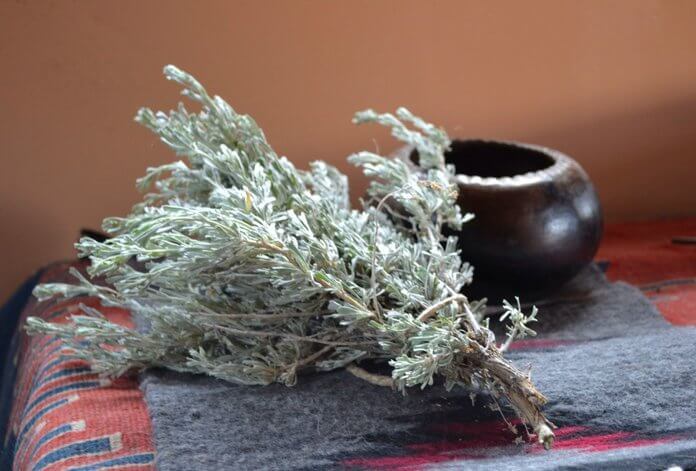

Other effective wormwood recipes
Wormwood to improve (stimulate) appetite: mix 8 parts of wormwood herb and 2 parts of yarrow herb, then take 1 teaspoon of the mixture and brew with 2 cups of boiling water, insisting, take 1/4 cup 3 times a day.
Subscribe to our Yandex Zen channel!
There is another way to use wormwood: roll a few wormwood flowers into bread balls and swallow them.
Wormwood root (decoction): we take 2 tbsp. tablespoons of chopped wormwood root (dry), pour 1 cup boiling water and boil for 10 minutes over low heat. To prevent the essential oils from evaporating, we close the dishes with a lid. After cooling - strain, take 2 tbsp. spoons 3 times a day, 20-30 minutes before meals, i.e. in fact, we drink all the cooked broth in a day.
Take a decoction of wormwood roots for oncological tumors and stomach cancer, rectal cancer, uterine cancer... In case of uterine cancer, external procedures (daily douching) are additionally made with the same broth, after diluting the resulting 1 glass of broth to 1 liter with boiled water.
Also, the root of wormwood is used for medicinal baths. with gout and neurosis. The course of treatment is 2 weeks.
Wormwood oil. We take fresh wormwood, put it in a jar up to the top, without tamping it, fill it with olive oil (you can use corn or linseed oil) and close it tightly so that no air gets inside, and leave for 10 days. The oil will turn dark green or pearlescent. Then strain it and store it in the refrigerator or some other cool place.
Wormwood oil is now commercially available. In Ukraine, it is made from Tauride (Crimean) wormwood. Used for inflammation of the respiratory tract, flu, cough, bronchitis.Cosmetologists recommend wormwood oil for the care of oily, impure skin, and is also used in aromatherapy.
For liver diseases it is advised to take powder from bitter wormwood and sage, in a ratio of components 1: 5. Take it 0.2-0.5 g 3 times a day.
Also, in addition to the diseases listed above, wormwood herb is used to treat scrofula and tuberculosis, hemorrhoids and articular rheumatism, epilepsy; taken with leucorrhoea, insufficient and irregular menstruation.
Wormwood infusion activates blood circulation and improves metabolism. Therefore, it is recommended with obesity and other metabolic disorders.
Wormwood for weight loss... We take the above recipe (wormwood infusion), only take it 1 tablespoon 3 times a day 15 minutes before meals. A mixture of herbs is also effective for losing weight: buckthorn, wormwood, tansy.
With fever and malaria taken orally infusion or decoction of wormwood.
Outwardly, wormwood juice is recommended with calluses (make a bandage), injuries. The juice helps to stop bleeding in case of injuries, it acts as a disinfectant and helps to tighten wounds.
Freshly mashed wormwood herb soothes pain in severe bruises and dislocations, it also works in sprains.
Wormwood infusion is used externally in the treatment of scabies, corns. The drug Kamazulene, isolated from wormwood, has an anti-inflammatory and spasmodic effect and is used for burns with X-rays, for eczema, rheumatism and bronchial asthma.
Wormwood tincture diluted with warm boiled water in a ratio of 1:10 is used for lotions with eye inflammation, as well as for compresses for inflammation of the periosteum, bruises, articular rheumatism.
Tincture of wormwood in half with water is used to disinfect the gums and oral cavity.
What is the benefit?
The active substances contained in this herb in significant quantities are capable of exerting a number of positive effects on the human body in combination. Here is a short list of the effects this plant has:
- anthelmintic;
- anti-inflammatory;
- antipyretic;
- choleretic;
- pain reliever;
- hypnotic;
- healing;
- anticonvulsant.
In addition to people suffering from severe diseases, preparations based on this plant are also quite useful for elderly people in order to slow down the aging process and obtain a tonic effect.
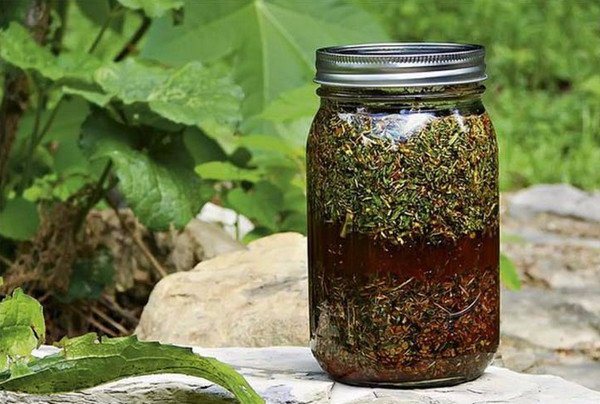

Read it in its entirety into your quote book or community!
Wormwood, ecru and marsala color in interiors + encyclopedia of designer color names


As soon as designers are not excluded in the names of color shades, so that they sound tasty and attractive. In this selection, we will consider the harmonious combinations of wormwood (blue-green) and ecru with marsala-purple hue, vanilla and ivory.


Just listen to these names that characterize the colors in the photo.
Gridfinny - pearl shade of gray, Currency - gray-green, dollar colors, Verdigri - green-gray, from fr. vert-de-gris, Verdragon - [French. vert dragon ‘green dragoon’; dragoon uniform green; another understanding is possible: dragon ‘dragon’] - a shade of dark green, Vermilion, vermilion - [French. vermillion 'bright red, scarlet; blush '] - bright scarlet with an orange tint, Viardot - [distorted fr. vert d'eau ‘green water’] - light green, aqua green, water green. Zhirazol - milky with an iridescent tint, zhirazol is the old name of noble opal.Zhonkilev - golden yellow, jonquil - one of the species of the genus narcissus. Isabella - pale straw, dirty straw pink. By the name of the Spanish queen Isabella, who gave in 1604. vow: not to change shirts for three years.


Lord Byron or Byrons - [on behalf of the English. poet J. Byron] - reddish, but rather dark shade of brown, close to dark chestnut. Bearish, bearish ear - reddish, but rather dark shade of brown. Lily - pale white, whiteness, tenderly reminiscent of lily
Red colors: sanguine, burgud, marsala, terracotta, brick, red currant, raspberry, pink (field carnation), pomegranate (dark red), cherry, amaranth (mahogany wood), lafite (red grape wine), burgundy, crimson (bright red), strawberry, strawberry, cyclamen (dark red with pinkish), lingonberry, pale pink, pink powder color, cranberry, raspberry red, ruby, red, scarlet, tomato, mountain ash, self (corporal with pink tint), coral, yellow-pink, almandine, akazhu, Adrianople, amethyst, gaff, crimson, cormorant.


Gully - asters. rose, rosewood; rosehip. Frantic - bright yellow, the color of the paint from the gorse dyeing flower.
It is customary to combine the colors of wormwood with pale pink, as well as with shades of Victorian pink, rose color, rich red, alizarin, orange, copper-red, pale yellow, apricot, thrush egg color, light green, gray-blue, blue, lilac, orange-beige, yellow-brown and chocolate color.
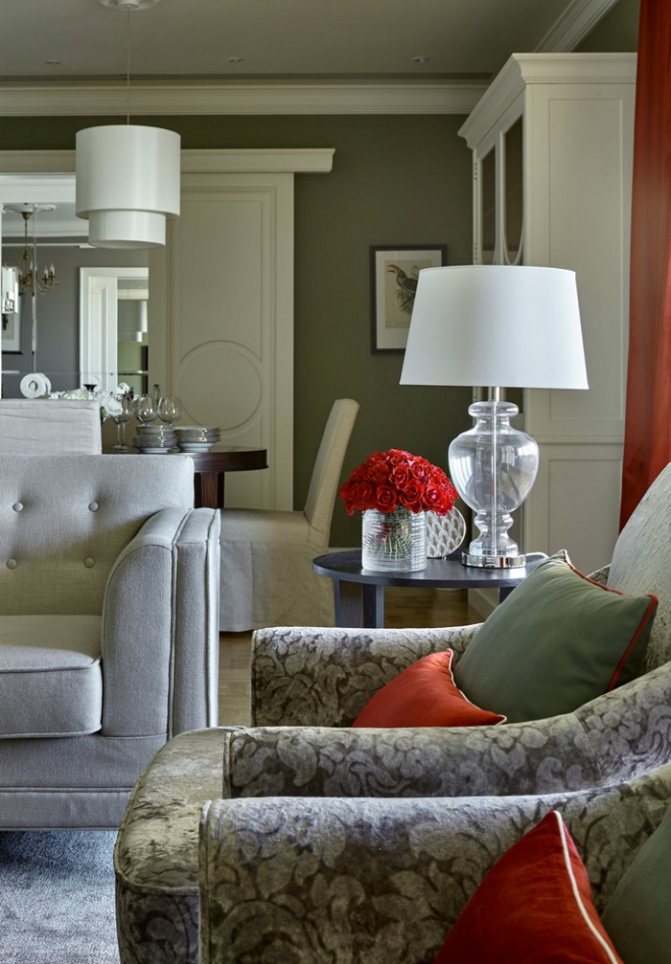

Not hard to spot in the photo Solovy - gray-yellow (named nightingale), Scaly - colors of comb, yellowish-sandy silk fabric, Ecru - ivory or unbleached, greyish-white, cream and Celadon - grayish green colors.


Bluish-green colors: ice, aqua, turquoise, peacock, myrtle (dark bluish green), cypress, wormwood, blue with a lilac tint, green bluish, bluish gray with green tint (eucalyptus), pale green, gray asparagus , jade, fern, moray, green moss, pang, dark green tea.
Zekry - light blue, gray.


Carmelite, Capuchin - a pure shade of brown. Bottlenose dolphin, beryl - silver-green-blue


Burmatny - [possibly from Polish. brunatny ‘brown, brown’ <middle-century-n. brunat ‘dark fabric’, middle-German. braun ‘brown’] - dark gray, as if covered with dust.
Scared mouse - pale gray color.


Biscuit - white with blue or green shades, biscuit - gray, gray, ecru, whitish, armor - white-gray
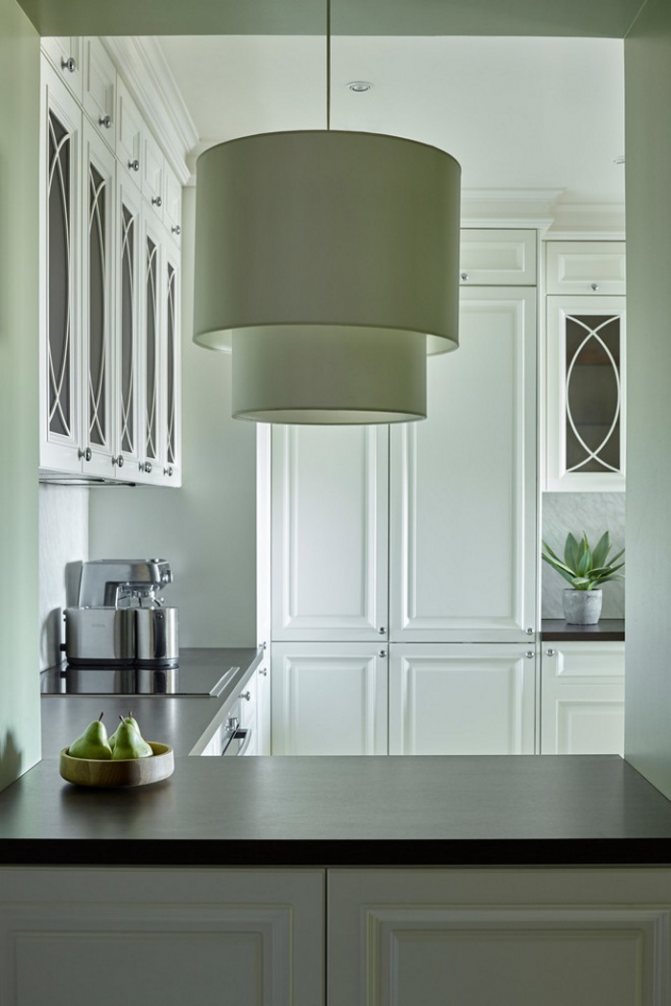

Gray color scheme: harsh, slate, smoky, lead, graphite, dusty, steel, light gray with a slight blueness, winter squirrel skin color, dark lead color, light gray with a blue tint, quartz, wet asphalt.


Purple colors: lilac, forest orchid, forest violet, amethyst, heliotrope (dark purple), garden violet, purple, iris, plum, beetroot, primrose, Persian lilac, fuchsia. ...


Beaujolais is a deep color of a beautiful violet hue, Broschany - crimson, purple, Bordeaux wine (burgundy, burgundy) - red-violet, dark red with a lilac tint. Crimson - purple.
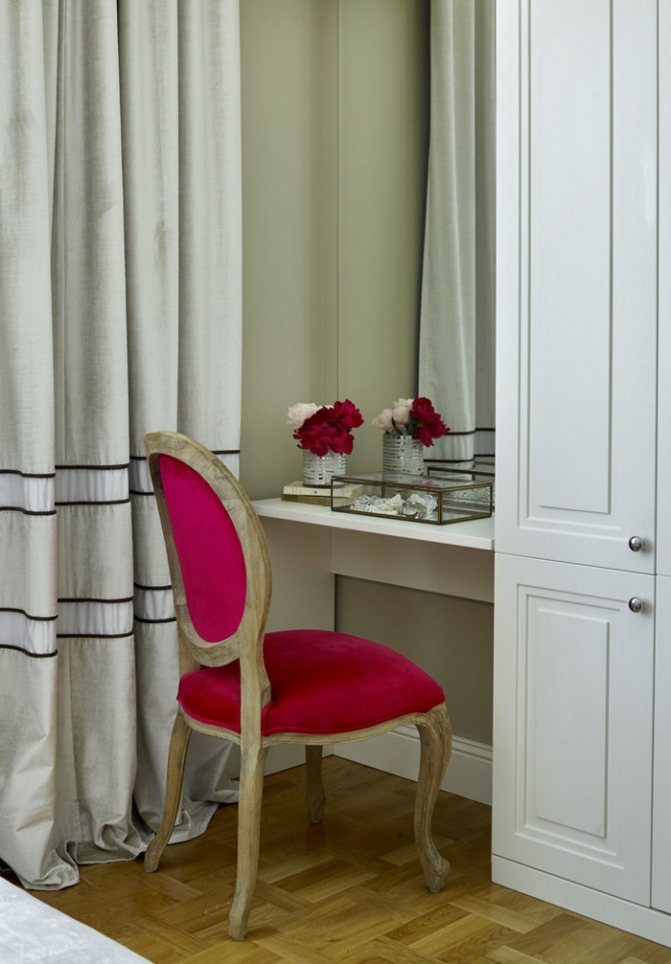

Incarnate - (from Latin ‘carneus’ meat) color of raw beef, crimson, raspberry. Judah tree - hot pink,
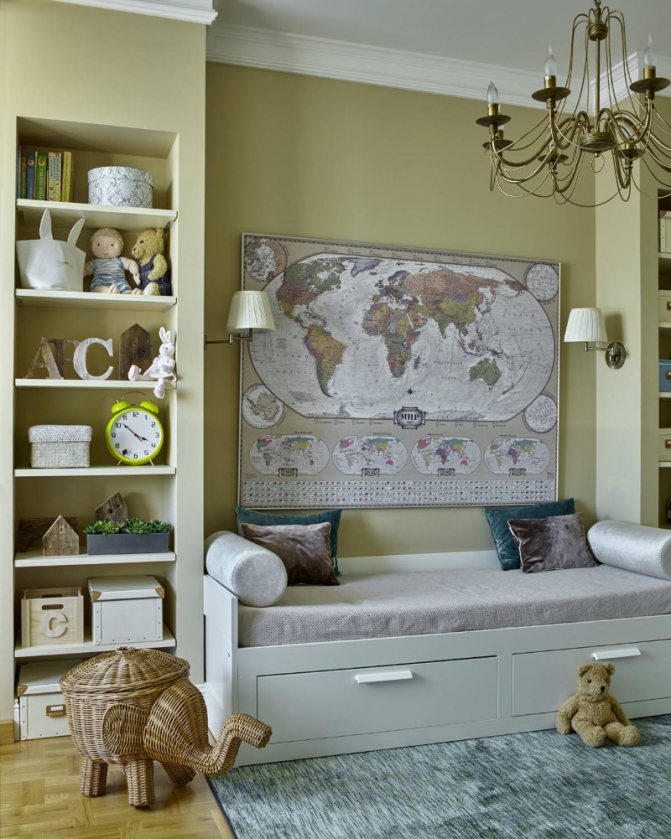

Blue colors: ashy, ash blue, sky blue, forget-me-not, sapphire blue, dusky blue, electric blue, hydrangea color, beaded - dark bluish-gray, waid - indigo ..


Bistre - brown
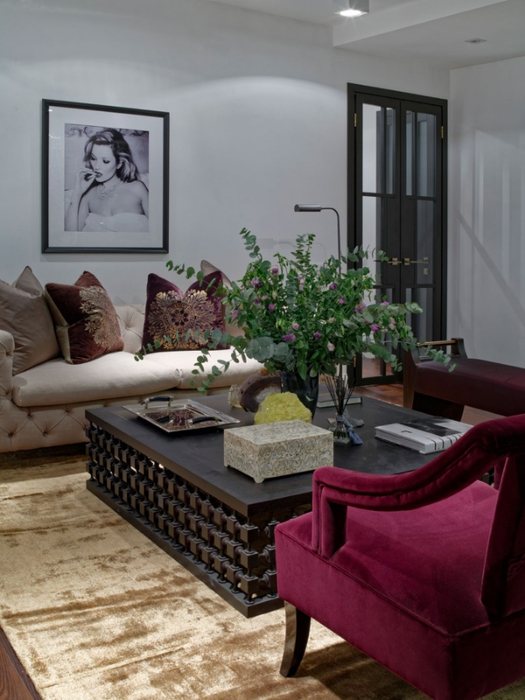

Blue colors: pervance (dark blue with a grayish tint), cornflower blue, ultramarine (blue color), indigo (dark blue), vat (deep blue), azure, blueraymond - bleu ‘blue’ + male name Raymond.
Gendarme - a shade of blue. There was even the expression "blue pants", which meant employees of the gendarme office.


Yellow colors: pearl, cream, lemon, straw, canary, fawn (pale yellow with a pinkish tinge), dry mustard color, tobacco, brass, amber, saffron (yellow-brown), yellowish with gray tint, banana, sand, bisque, blange - yellowish white, brownish.
Yellow-green colors: apple, pea, olive (yellow-green), pistachio (greenish), herbaceous, mignonette, khaki (brownish-green), emerald.


.
Orange colors: tangerine, carrot, orange, golden, rust color, ecru (old ivory with a bronze tint), beige (light brown with a yellowish tint), coffee with milk color, milk with coffee color, tan color, havana (cigar color) , terracotta (reddish brown), chestnut, coffee, autumn (aspen) leaf color, brown, chocolate, nutmeg (nutmeg), sandalwood, bronze, bison - dark orange
Labrador - color of labrador, feldspar stone, white or gray, Castor - dark gray, castor color, woolen woolen cloth.Columbine - (from the French 'colombin' pigeon) pigeon, gray.
Vat - bright blue, deep blue, from the name of the plant cube (it is also indigo). Marina, Marina - the color of a light aqua, from the French. marine, marine, Pervance - grayish blue, pale blue with a lilac tint.Milori - dark blue, blue, Prussian blue. Tausinny - blue, from the word "peacock". Bluish purple. dark blue with cherry tint. There are options tagashinny, tagashy. Schmalt - blue, from the name of the paint, which was made from crushed blue glass (smalt). Yubagry (ubagry) - purple, light purple; light blue. Pan - reddish-red, the color of polished copper dishes, KashU or catechu - red-brown, brown, tobacco. Obtained from acacia wood catechu Cochineal - from paint cochineal, extracted from insects, crimson, worm, bright red, slightly crimson. Speckled, speckled - scarlet, madder, bright red, from him. Krapplack, the color of the Krapplack dye extracted from madder root.
Prazemny - the color of prase, light green quartz. Aspen - green with a grayish tint. Muramous, moire - grassy green. Offit - the color of ophite, greenish marble. Prunely - a shade of black, named after the color of ripe mulberry berries; at first, the shade was associated with the prunel fabric, which was once only black.
ivory and bleached oak
Mordore, mardore - a color from a red-brown range with a golden sheen. The name comes from the French more dore, literally "gilded moor". This color was especially fashionable in the 1st half of the 19th century. Massaka - dark red with a blue tint .. Savoyarsky - color from the red-brown range with a golden sheen, Scarlatny - bright red, from the English. scarlet.Solferino - bright red. Strizovy - bright red.Chervonny - red, scarlet, bright red.
Chermnoy - red, dark red; turbid red color. Sharlach or sherlak - bright red, from the name of the paint, the color and paint are bright crimson, scarlet .. Pusovy - brown, brown shade of red, the color of a squashed flea from the French puce "flea"
. Moscow fire - similar to the color of crushed lingonberries, Nakaratovy - a shade of red, "hot", scarlet. From the French. naca-rat.Enlightened - crimson, Crimson - bright, dense or dark scarlet (wormy). Orletsovy - red-cherry-pink, eagle-colored.Porphyry - purple, crimson; (from the Greek porphyreos - purple)
Tourmaline - dark crimson, Fernambuck - yellow-red, dye from fernambuca wood - red sandalwood, Caesalpina dye wood, Milling cutter, milling cutter - [from the French. 'Fraise' strawberry] crushed strawberry color, light crimson. pink with a lilac shade. Somo, somu (somon) - from the French.saumon salmon, salmon: light pink-yellow, flesh-pinkish yellow.
Cary - dark, brown.Gloomy - brown shade of gray, dirty gray, dark, mixed color, beech-black-gray, dark gray, dark brown. So the peasants called the dark gray color. It turned out this way. When making homemade woolen fabrics, the yarn was rarely dyed. Materials from it were obtained in various dirty gray shades of the color of natural wool - sometimes with a brownish tint. Marengo - gray interspersed with black. It appeared after the Battle of Marengo in 1800. The fact is that the local handicraft fabrics were mostly dark gray in color. London smoke - dark grey. Marengo-Claire - light gray. Parnassian rose - a shade of pink with a purple tint. Magician-ghoul - red-pink. Mov - mauve. Movein (FR. Mauveine - aniline purple) - the first synthetic dye, obtained in 1856. Magenta - with ital. - bright red, magenta, from English. - purple, between red and purple. Color from mixing red and blue light, narrowed range from magenta sector. It looks like a fuchsia flower. Perhaps the name arose after the battle near the town of Magenta (northern Italy) in 1859.


Redry - brown, red, reddish. Ore - yellow with a reddish tinge, rusty. Sepia (he is chinese ink) - brown, a dye extracted from cuttlefish ink. Orange - orange, ore yellow, hot. Dahl has an orange - a tree and a bitter orange fruit. Oreldursoy - reddish, but rather dark shade of brown.
Nankovy (Nanking, Nanjing) - the color of rough cotton fabric, once brought from Nanjing: dirty yellow. Opal - milky white, dull white with yellow or blueness.
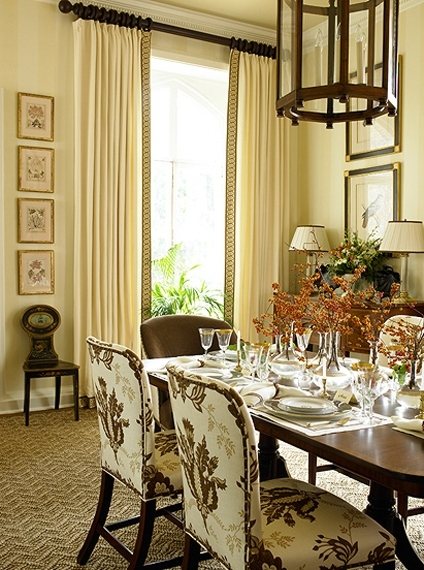

Asparagus - asparagus color: olive. Pale yellow - pale yellow, dull yellow, pinkish-beige shade of yellow, from fr. paille "straw". Dahl is straw-colored, pale yellowish. White-yellowish, from yellow-white; yellow-whitish; about horses: salt and isabella; about dogs: sexual; about pigeons: clay. Karamzin glorified pale cream.
Chrysoprase -: juicy green, Cynical - green.Yar-copperhead, copperhead is a bright green paint obtained by oxidizing copper.Electron - bright blue with green.Smaragdine - emerald color (outdated name for emerald).
Dauphin's surprise. He - color of child's surprise... According to legend, in Paris they began to dye fabrics in the color of the finished diapers after Marie Antoinette showed the courtiers her two-hour-old son, who was just born in front of them.
Ecru color "Ecru" means "unprocessed" or "unbleached"
Tango - orange with a brown tint. The name is based on the dance of the same name. Grays last breath - yellow-red. Perhaps because before death, the eyes of a parrot turn yellow. Fluent - light yellow. Dahl is yellow-whitish, white-yellow, straw-colored. Chrysolite - yellowish green, Chartreuse - yellow-green .. Shamub - [from the French. 'Chamoi' camel] light reddish brown.
Yufty, Yuftyanoy, Yuhotny - leather shade of brown - yellowish-light brown. The color of yuft was widespread in the first quarter of the 19th century, Lavalier - leather shade of brown - yellowish-light brown. Came into fashion, unlike yuft, only in the middle of the 19th century. Doe (from the name of the animal) - yellowish brown.
Shanzhan - multi-colored fabric with a contrasting texture. By using differently colored yarns for the warp and weft in the production of smooth fabrics, an iridescent color effect is obtained, the so-called. the "shangjang" effect.


Tea to normalize digestion
If you are experiencing abdominal discomfort: bloating, flatulence, nausea and gas, then it is worth taking a course of treatment with tea made from annual wormwood.To do this, mix 1/4 cup boiling water with a teaspoon of dry bitter wormwood. After that, the drink is infused for 10 minutes and consumed 3 glasses a day. The tea will taste bitter, but it shows high efficiency in the fight against abdominal discomfort. Wormwood tea also helps fight kidney stones, gallstones, and jaundice.
Where and how it grows


The medicinal plant is widespread throughout Europe (except for the northern taiga, tundra and semi-desert areas), as well as in the southern part of Siberia (up to the Yenisei) and in the Caucasus.
This bitter herb grows along roads, in vegetable gardens, in orchards, in pastures, sometimes it can be found on forest edges, meadows or coastal slopes.
Wormwood blooms in the interval July-August, and the seeds of the plant ripen in August-October.
Bitter wormwood is harvested during the flowering period.
Description of the plant
It is a perennial, up to 150 cm high. You can see how wormwood looks like in any field. Stems are of a shortened and straight type. Flowers are yellow or red, small in size. The root system is woody. The smell of grass is pungent, the taste is bitter. The plant is quite hardy - it is not afraid of drought and frost.
On the territory of Russia, there are 180 species found everywhere. In areas where bitter shrubs grow, it is usually arid. These are deserts, steppes of Kazakhstan, Central Asia, Transcaucasia, Ukraine. Sometimes found in the south and east of Russia and in Western Asia.
Are there any contraindications?
Absolute contraindications to the use of drugs based on wormwood can be considered pregnancy and lactation. It is not recommended to abuse these drugs for people suffering from thrombophlebitis of the lower extremities, as well as those who have gastrointestinal diseases in the acute stage.
Wormwood should be used with caution in older people who are overweight. Before giving medicines, which include wormwood, to children under 12 years of age, prior consultation with a doctor is required.
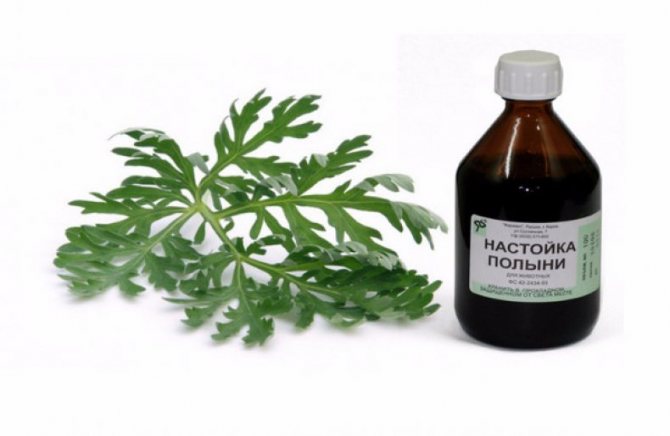

Preparations based on wormwood cannot be used for periods of time longer than one month, since its components, when accumulated in the body, can cause side effects in the form of dizziness, muscle tremors, hallucinations and mental disorders.
We hope that this material helped you come to an unambiguous conclusion about whether you should use preparations based on this plant for health purposes. Remember that traditional medicine is certainly very good, but you should not completely rely on it when a problem arises. If the need arises, be sure to consult your doctor. Be healthy!
Procurement and storage
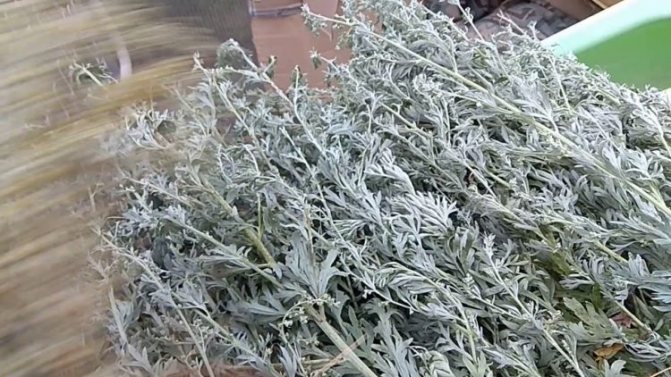

- During collection, you should be interested in the tops (panicles) of a flowering plant. It is necessary to cut the stem up to 25 cm long (most often the coarse parts of the grass are cut off and discarded). Despite the fact that the aerial part is considered the useful part of the bitter wormwood, it is quite permissible to use the root of the plant, more precisely, its soft shoots. The root must be dug up in the fall and dried in the same way as the flowers.
- It is important to collect the flowering fruits of the plant at the very beginning of flowering - June-July (depending on the region). The leaves are torn off in May, before they are hardened and not so bitter.
- During the drying process, the raw materials are laid out in a thin layer under a canopy, or the shoots of the plant are collected in a bunch, which, in turn, is hung in a ventilated room.
- For high-quality and long-term storage, linen bags or wooden dishes are used. The roots and the upper part of the wormwood can be stored for up to 3 years, and the leaves for up to 2.

